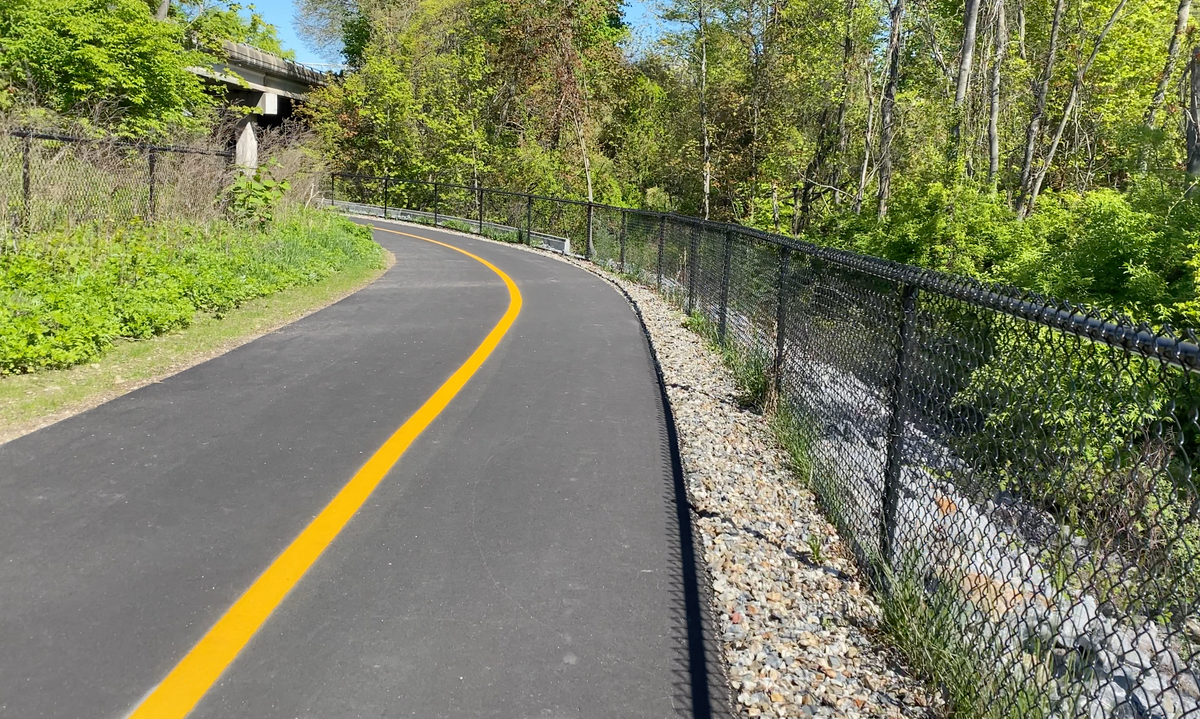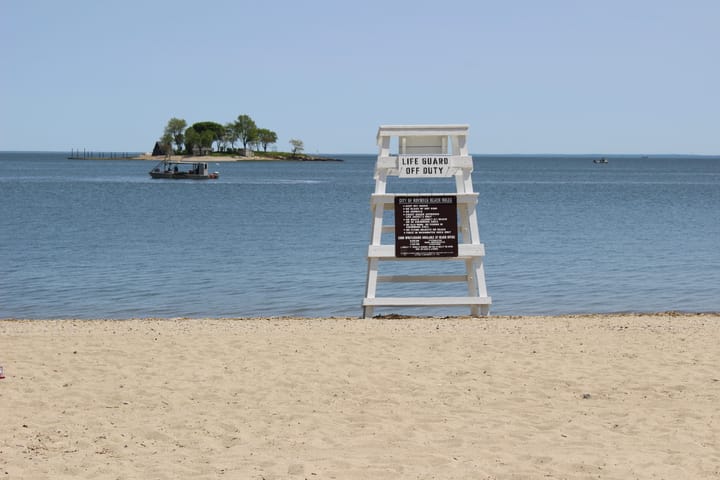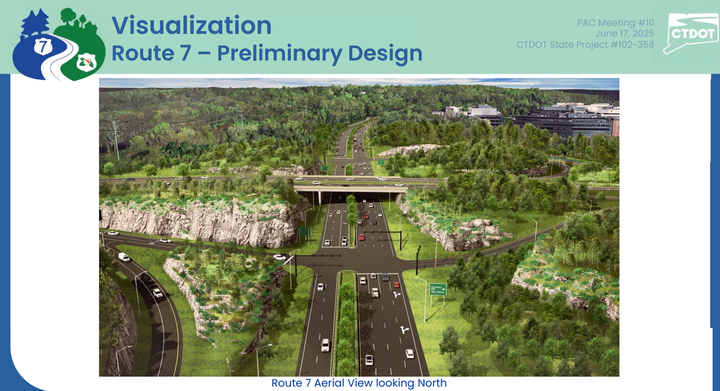Funding for Norwalk River Valley Trail Opens Up New Options for Residents
A $4.5 million federal RAISE grant will allow the Norwalk River Valley Trail to finish planning and designing its remaining portions.

For Nicholas Pappas, biking to his job in Wilton from his home in Norwalk isn’t always the easiest trip.
“The way to get to Wilton is definitely more designed for cars,” he said. “Sharing the road with cars is something that I try to avoid, especially if I’m ending up on Main Avenue or what turns into Route 7—it gets really busy and can get kind of daunting with all the cars traveling so quickly. I try to find back roads, but then I’m also not taking the most direct route.”
But he and others are hopeful that, thanks to a $4.5 million grant, they’ll soon have a new, safer way to make the trip along the Norwalk River Valley Trail. Representative Jim Himes announced recently that the 30-mile trail would receive a federal RAISE—Rebuilding American Infrastructure with Sustainability and Equity program—grant, which would be used to cover the planning and design work needed to finish the trail.
“I’m overjoyed that I was able to support WestCOG and the Friends of the Norwalk River Valley Trail in securing $4.5 million in federal funding so that they can complete work on what will be the longest bicycle and pedestrian trail in Fairfield County,” Himes said in a statement.
“I do try to get around without a car as much as possible,” Pappas, who is also the newest member of Norwalk's Bike/Walk Commission, said. “And having trails that don’t intertwine with roads for cars definitely helps out a lot with that, just in making things quicker, easier, and safer.”
Andrea Gartner, the executive director of the NRVT, said that with the projects they currently have in the works, by the end of next year 15 miles, or about half of the trail, will be completed. This grant will help them continue their work, which she said has become essential to the region.
“There’s been a cultural shift for us in this part of the country, where the idea of having an amenity like a walkable trail—to be able to get outside, to be able to get into nature—has moved beyond a nice to have in a community and has become more a necessity,” she said.
The grant funding will go toward designing, planning, and engineering the remaining miles of trail, some of which are in more complicated, hilly areas, she said. The plans for the trail call for connecting Norwalk to Danbury, running through Wilton, Ridgefield, and Redding.
“More than 30 miles running through the heart of Southwest Connecticut, this trail provides a path for families to walk along the Norwalk River, hikers the chance to climb Connecticut hills, and commuters a way to bike to work safely and conveniently,” Himes said in a statement. “This project will not only connect our cities and towns, but also encourage the good physical and mental health benefits that come with spending time in nature.”
Benefits of the Trail
Gartner said that this will really open up opportunities for residents along the trail, particularly because the trail not only serves as a way to get around, but also connects people to other methods of transportation.
For example, she said that residents in Ridgefield can take the train into Norwalk and use the trail to get to some popular spots, like the Maritime Aquarium, or allow Norwalk residents to enjoy a hike in the woods up through Wilton.
While many people use the existing trail for recreation, Gartner and others said that they believe it can also serve as a way to help connect people to their employers and provide an economic boost to the region.
“We have a lot of interest, especially with young professionals, who want to be able to use the trail for community to work—if that means taking their bike on the train and then making it mix and match between rail—that’s a very exciting possibility,” she said.
Many of the region’s employment centers are close to the trail including:
- Norwalk Hospital
- Merritt 7 Corporate Office Park
- ASML in Wilton
- Wilton Corporate Park
“I really think it does speak to that health and wellness, being able to connect to other communities, and visit. It’s an economic driver in that sense,” she said.
Tanner Thompson, chair of Norwalk’s Bike/Walk Commission, emphasized the importance of these connections.
“We’re setting up the NRVT to be the backbone of the walking, biking network in Norwalk,” Thompson said.
Thompson said that as the trail gets more completed, it will enable more people, like Pappas, to have another option to get to their jobs and run daily tasks.
“Walking and biking are forms of transportation that a lot of people rely on—I’ve seen estimates as high as 2,000 households in Norwalk don’t own a car—and so we already have a lot of people that are relying on non-car transportation,” Thompson said. “So a safe route for them is critical.”
Thompson also noted that even for those with cars, the trail could even help reduce the number of trips that people are taking if the trail—and other infrastructure—can provide safe alternatives to get around on foot or bike.
“The more that those people can avoid using their car, the more they can avoid contributing to traffic, contributing to pollution,” he said.
Thompson also noted that biking and walking can play a role in improving people’s physical and mental health, something that a lot of people discovered during the COVID-19 pandemic.
“I firmly believe that building infrastructure like the NRVT is building physical healthcare and mental healthcare into the built environment of our city, and it will pay huge dividends,” he said.
Gartner said that the NRVT’s data backs this up.
“We have a trail counter on our Wilton trail that showed an increase in usage of 260%,” she said.
Pappas said that he enjoys using the trail to get places in Norwalk, so he’s looking forward to using it to get to Wilton and beyond.
“I’ve used the portion of the NRVT in Norwalk to get around—go to the library, get to the beach, and it’s really great,” he said. “So being able to extend that all the way to Wilton could really make things a lot easier for me, someone who does want to get around without a car and be able to get some exercise and not contribute more to the traffic and pollution.”
How the NRVT Got the Grant
Gartner said that since about half of the trail will be completed by the end of next year, she thought it was a good idea to start looking around for opportunities to help finish the remaining route, which she said is the more difficult portion.
“We have some real challenging areas as we come north,” she said. “We don’t want to exceed an 8% grade—we want to be universally accessible—so as you come north, it gets hillier.”
As a part of their research last year, they learned about the RAISE program and thought that even though it’s a competitive grant, they’d be a good fit.
“We qualify as infrastructure as an alternative mode of transportation,” she said. “It turns out there’s a lot of funding available because we are a regional project. We are located in Fairfield County where the air quality is poor, so the more cars we can get off the road, there’s funding towards that end. There’s funding for connectivity to connect people to train stations, to get them to their employers.”
But she said they realized that the NRVT couldn’t be the applicant for the RAISE grant, because it isn’t a government entity, so they partnered with the Western Connecticut Council of Governments, known as WestCOG, to submit the application. WestCOG is a regional planning organization that includes 18 communities in western Connecticut, and the leader of each community—mayor or first selectman—serves on its council. It provides planning services, related to land use, emergency management, and environmental issues, and aims to promote cooperation among the municipalities in the region.
“This project will decisively accelerate the completion of the Norwalk River Valley and Still River Trails and catapult forward the vision of economically vibrant and environmentally sustainable multi-use trail running the length of Western New England—from Long Island Sound to Litchfield County and north,” said Francis Pickering, executive director of WestCOG, in a statement.
Next Steps
While the grant is a huge boost to the NRVT efforts, Gartner noted that there is still a lot of work to be done. For starters, the grant is set up as an 80-20 grant, where 80%, or about $4.5 million in this case, comes from the federal government, but the NRVT is required to raise the remaining 20%.
The grant will be used to get trail projects “shovel ready,” meaning all the pre-work like land surveys, engineering, and design will be covered, but then the NRVT has to raise funds for the actual construction.
Gartner said that they’re actively looking for donations, other grant opportunities, and volunteers.
To learn more about the Norwalk River Valley Trail and get involved in its work, visit nrvt-trail.com.



